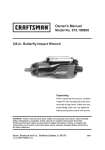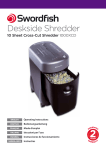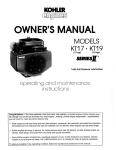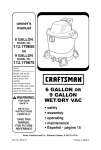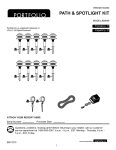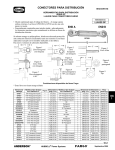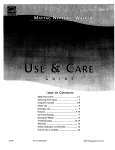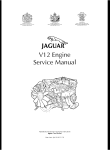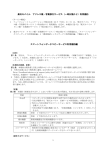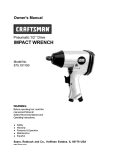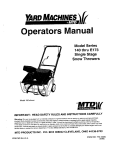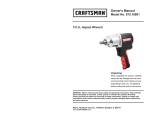Download Craftsman 875.199330 Owner`s manual
Transcript
Owner's Manual Model No. 875.199330 3/8-in. Ratchet Wrench Unpacking When unpacking inspect occurred loose before this for any damage during fittings, putting transit. bolts, this product, carefully that may have Make sure any etc. are tightened product into service. WARNING: Please read and save these safety and operating instructions. Read carefully before attempting to assemble, install, operate or maintain the product described. Protect yourself and others by observing all safety information. Failure to comply with instructions could result in personal injury and/or property damage! Retain instructions for future reference. Sears, Roebuck and www.CRAFTSMAN.com Co., Hoffman Estates, IL 60179 o807 Owner's Manual Model No. 875.199330 Owner's Manual Mode! No. 875.199330 90 PSI Maximum This tool is designed to operate at an air _, Features ONE YEAR FULL WARRANTY & Benefits CRAFTSMAN _, Specifications _, Product Warranty _, Compressor Important ON TOOL If this Craftsman tool fails to give complete Requirements satisfaction within one year from the date Safety Instructions _, Installation and Operation _, Maintenance of purchase, _, Exploded View Drawing & Parts List OUTLET IN THE UNITED STATES FOR gauge pressure (90 PSI) maximum, instructions tool. Use of higher air pressure can, and and warnings The Craftsman Model 875.199330 3/8" such as automotive general assembly, transmission and maintenance. may cause injury. Also, the use of higher Always Wear Approved Eye Protection Impact resistant eye protection this Educational teardown Features include a lever ratchet head height (without socket) for applications. 360 ° swivel exhaust directs air away from This warranty expendable batteries, does not include parts, such as lamps, bits or blades. should set forth in gives you specific legal rights, and you may also have other rights which vary from state to state. operator. Sears, Roebuck and Co., Hoffman Estates, IL 60179 under loads and stresses premature tool failure. California Prop 65 and Eye and Face Protection. Look for marking Z87.1 on your eye protection to ensure that it is an approved style. Some dust created by power Hearing Protection Hearing protection is Recommended should be used when the noise level exposure sound level of 85dBA. average known to cause cancer, or other reproductive Some examples of these chemicals nearby, all add to the noise level determine your noise level exposure, we masonry chromium lumber. products, arsenic and the use of hearing protection. Avoid Prolonged 3/8" Free speed (No Load) .............. 160 RPM Max Torque ................................ 50 ft. Ibs. Weight ........................................... 2.3 Ibs. Overall length ..................................... 10" Average air consumption ........ 4.0 SCFM Recommended hose size .......... 3/8" I.D. Air inlet ....................................... 1/4" NPT Maximum Air Pressure .................. 90 PSI Typical Use - 26 Gallon Prolonged exposure repetitive to Vibration to vibration or very hand and arm movements cause injury. Discontinue Heavy Use - 33 Gallon Professional tool if you experience discomfort can the use of any tingling, numbness, depending varies, on how often you do this type of work. To reduce your exposure to these chemicals: work in a well ventilated area, and work with approved safety equipment, such as dust masks that are specifically out microscopic designed to filter particles. or pain in your hands or arms. You should consult your physician before resuming ENG-2 Exposure Pneumatic tools can vibrate during use. Light Use - 17 Gallon are: from chemically-treated Your risk from those exposures Drive size ........................................... birth harm. Lead from lead based paint, crystalline silica from bricks and cement and other in a given work area. If you are unable to recommend chemicals Process noise, reflective surfaces, other tools being operated sanding, sawing, grinding, drilling and other construction activities contains defects equals or exceeds an 8 hour time-weighted This warranty components they were not designed for, causing repair, throttle for speed control and low profile use in close-quarter or rental purposes, applies for only 90 days from the date of purchase. Drive Ratchet Wrench is designed for applications tool is ever used for at the air pressure places the internal ANSI Z87.1, Occupational If this Craftsman commercial before operating any pneumatic tool, meet or exceed the standards FREE REPLACEMENT. warranty pressure of 90 pounds per square inch Instructions Please become familiar with all the RETURN IT TO ANY SEARS STORE OR OTHER CRAFTSMAN _, Troubleshooting Read Operating use of tool. ENG-3 Owner's Manual Disconnect Model No. 875.199330 the air tool from air supply and during non-operation. Do not wear loose fitting clothing, Manual Some materials before changing tools or attachments, servicing Owner's tar, contain Use attachments designed for use with air powered tool. Always examine could accessories prolonged before mounting for chips, such as adhesives chemicals cause serious Mode! whose injury exposure. and vapors with Always No. 875.199330 work in a Tools which cut, shear, drill, staple, punch, chisel, etc. are capable of scarves, or neck ties in work area. Loose cracks, causing serious clothing may become caught in moving Never use mounted points or other working part of the tool away from parts and result in serious personal accessories that have been dropped or exposed to water, solvent or extreme hands and body. Do not wear jewelry when injury. operating any tool. Jewelry may become caught in temperature clean, dry, well ventilated of damage. enclosure for one minute after mounting injury. Do not depress trigger when connecting area. any accessory. Tools which contain moving or drive other grinding moving wheels, elements, tools, such sockets, sanding discs, Never trigger hair, clothing, jewelry and other loose objects, resulting in severe injury. the tool when not applied Attachments attached. Always rating must be securely Loose attachments can cause use accessories with an RPM that meets or exceeds the tool RPM rating. which Never point an air tool at oneself other person. Serious injury could occur. Never carry a tool by the hose or pull the hose to move the tool or a Check compressor. air hoses or any for weak or worn before each use. Make sure all connections Keep hoses heat, oil and sharp loose straps tool. might become parts. Inhalation before as grinders, to install, service, or perform any maintenance. generate which and screws tight and ensure equipment is in safe working condition. the exhaust oil port during the first few seconds of operation. Thus, the exhaust port must be covered with a towel before applying air pressure. hazard: Abrasive sanders caught by the Always make sure that tool accessories meet or exceed the tools reccomended output. any weak or worn. tools, such and cut-off tools dust and abrasive can be harmful materials to human maintained tools and can cause serious injury. the tool with care. A properly maintained Disconnect servicing tool from air supply or changing before sockets. tool, with sharp cutting edges, reduces the risk of binding is easier to control. and When tightening, do not torque down the nuts or bolts with the ratchet as lungs and respiratory system. MSHA/NIOSH approved, Always wear properly fitting damaged. There is a risk of bursting face mask or respirator such tools. when using binding if the tool is Check for misallgnment of moving parts, breakage typically done with a hand wrench. This or can damage the tool by breaking parts of in the ratchet mechanism. parts and any other condition that affects the tool's operation. If damaged, have the tool serviced ENG-4 through which Tie up or cover long hair. Maintain Release all pressure from the system Keep all nuts, bolts an air tool has been lubricated, will discharge or ties, that could Keep hands away from moving improperly accessories relocate in After away from edges. Replace hose that is damaged, are secure. attempting Keep the become tangled in moving parts of the tool. Remove any jewelry, watches, etc., or puncture. conditions entangled Never wear loose fitting apparel contains serious injury. Protect air lines from damage etc., can become as the air supply hose. to a work object. injury. changes. It is a good practice to operate the tool in a protected moving parts and result in serious personal or signs before using. ENG-5 Owner's Manual Model No. 875.199330 Owner's Manual be a flexible Air Tool Hook Up movement Mode! No. 875.199330 hose in order to isolate of the compressor. This ratchet is equipped with a lever Route the initial take-off line (pipe) as throttle which allows the operator to vary straight the speed. Direction control is located on up the shop wall and as high as possible. This will help minimize water leaving the compressor traveling and through system. the back of the ratchet head. Initial tightening and loosening of fasteners should be done manually with ratchet used as a hand tool. Nuts may then be run on Slope the main lines down at least and off with relative ease. 3/4 inch per 10 feet of pipe away regulator (Ref. No. 2) allows user to set from air compressor; torque level to the job. (Fig. 2) the condensate this will draw Built-in air with the flow of air and away from the compressor. Keep socket firmly against work surface when running the ratchet to avoid Before the tool is connected to the air supply, clear the air hose of accumulated dust and moisture although specifications The wear. hose to move the tool or a compressor. further the drop, the more that Keep hoses away from heat, oil and sharp condensation edges. Replace any hose that is damaged, drier the air will be when it reaches weak or worn. the water separator. Small (home) shop hard piping: is shown. Some helpful tips are: A 3/8 inch ID air hose is required up to a higher pressure length of 25 feet. A 3/8 inch ID hose encounter. than your system will If Be sure all hoses and fittings are the correct size and correctly secured before using the tool. explosion the water separator, air piping systems and serious as injury may result. The connection The ratchet should never be used to set the torque. Use a torque wrench to that get into install the take- supply line for each air drop. A Drain line should be placed at the drainage. Never use PVC pipes for compressed Speed Adjustment set the torque. end of the main line for condensate longer than 25 feet will cause a pressure more length is required, a ½ inch ID air gear off line on the top of the main air Always use hoses and pipes rated for hose is recommended. can occur, and the will result in premature In order to reduce the amount of hose hook up. drop and may impede performance. for a small shop). water and contaminants air the socket from the anvil. unrealistic A piping diagram for a typical home shop 1 Illustrates a recommended Excessive torque leverage above the tool as the size of your shop will allow (50 feet is optimal, Air Hoses for your Air Tools Figure dislodging compressor Never carry a tool by the hose or pull the by running air freely through the air hose for 5-10 seconds. Place the first drop as far from the When tightening, do not torque down the nuts or bolts with the ratchet as typically done with a hand wrench. This can damage the tool by breaking parts in the ratchet mechanism. Drain valves should be placed at the end of branch lines and the drain line, and drained daily. from the compressor to the initial take-off hard pipe must ENG-6 ENG-7 Owner's Manual Model No. 875.199330 Owner's Exploded Manual Mode! No. 875.199330 View Drawing Lubrication An in-line filter-regulator-lubricator (Figure 1) is recommended as it increases tool life and keeps the tool in sustained operation. The in-line lubricator should be regularly checked and filled with air tool oil. Proper adjustment of the in-line lubricator is performed by placing a sheet of paper next to the tools exhaust ports and holding the throttle open approximately 30 seconds. The lubricator is properly set when a light stain of oil collects on the paper. Recommended Lubricants 2 Use air tool oil or any other high grade turbine oil containing moisture absorbent, rust inhibitors, metal wetting agents and an EP (extreme pressure) additive. See (Figure 2) for location/air inlet. Excessive amounts of oil should be avoided. In the event that it becomes necessary to store the tool for an extended period of time (overnight, weekend, etc.), it should receive a generous amount of lubrication through the air inlet (Figure 2). The tool should be run for approximately 30 seconds to ensure oil has been evenly distributed throughout the tool. The tool should be stored in a clean and dry environment. Parts List REF# Air Regulator or ere Figure ENG-8 2 PART# DESCRIPTION QTY 1 2 8106660 8106661 _ ousing _dr Regulator 1 1 3 4 5 816043 8106511 942502 D-Ring Throttle Dowel 6 7 8106665 8106666 dalve Stem T hrottle Lever 8 8106667 _dr Inlet Lever Pin Pin Bushing REF PART # DESCRIPTION 30 9106688 JV asher 3I 32 9106680 9106681 internal Gear =la n et Gear 33 34 9106682 9106683 _ eedle Roller die G ear Seat 1 1 35 36 9106694 9106695 Drnamental 1 37 9106696 38 39 9106697 9106488 1 1 1 31amp 8ushing 3rank QTY 1 1 Gasket Nut Shaft 9 8106365 D-Ring 1 10 11 8106669 8106670 nlet Adaptor Hasher 1 1 12 8106671 Screw 1 40 41 9106699 9106489 13 14 875015 8106673 dalve Spring T hrottle Valve 1 1 42 43 945038 9150340 Reverse 15 8106674 dalve 1 16 8106675 _ eedle Bearing 1 44 45 9106490 945052 _o ckin,q JV asher 17 18 19 8106676 8106677 8106678 4andle D-Ring Exhaust Grip 1 1 1 46 945020 Ratchet Anvil 47 48 945037 945036 M eedle Ratchet Roller Pawl 20 8106679 Vluffler Cover 1 8106680 8earing Cap 1 49 50 9150320 9150390 Thrust 21 22 23 24 8106230 8106682 8106683 3all Bearing Rear End Plate Rotor Blade 1 1 4 5I 915043-A 52 53 9I 5044-A 9150400 Spring SteeJ (3/8" / BaH (3/8") 25 8106684 Rotor 1 8106685 8106686 8106687 Spring Pin £ylinder =font End 2 1 1 54 55 56 9150410 9160A55 945022 B all 26 27 28 Spring Steel = in 57 91650A57 29 8106688 3all Cap Seat Deflector Bearing Plate Drive B ushin,q Ratch et H ousing Ratchet Yoke Switch Spring 88 11 1 11 11 1 19 Pin W asher Retainer Ring _, nvil Bushing JV asher 1 99 11 1 19 1 1 1 ENG-9 Owner's Tool runs slow or will Manual 1. Grit or gum in tool not operate. Model No. 875.199330 1. Flush the tool with air tool oil, gum solvent, or an equal mixture of SAE 10 motor oil and kerosene. Lubricate the tool after cleaning 2. No oil in tool 2. Lubricate the tool according to the lubrication instructions in this manual 3. Low air pressure 3a. Adjust the regulator on the tool to the maximum setting (If applicable) Owner's Manual Model No. 875.199330 Ratchet mechanism Ratchet mechanism la. Clean mechanism slips or will not loosen is dirty lb. Replace worn mechanism with air tool oil Notes: 3b. Adjust the compressor regulator to tool maximum while the tool is running free 4. Air hose leaks 5. Pressure drops 4. Tighten and seal hose fittings if leaks are found 5a. Be sure the hose is the proper size. Long hoses or tools using large volumes of air may require a hose with an I.D. of 1/2" or larger depending on the total length of the hose 5b. Do not use multiple number of hoses connected together with quick connect fittings. This causes additional pressure drops and reduces the tool power. Directly connect the hoses together Moisture blowing out of tool 1. Water in tank 1. Drain tank. (See air compressor manual). Oil tool and run until no water is evident. Oil tool again and run 1-2 seconds 2. Water in the air lines/ hoses 2a. Install a water separator/filter. NOTE: Separators only work properly when the air passing through the separator is cool. Locate the separator/filter as far as possible from the compressor 2b. Install an air dryer 2c. Anytime water enters the tool, the tool should be oiled immediately ENG-10 ENG-11 Manual del Propietario Modelo No. 875.199330 Llave de apriete de trinquete de 3/8 pulg Desempaquetar Despues de desempaquetar examinelo cuidadosamente identificar ocurrido el producto, para daSos que pudieron durante Cerci6rese accesorio, de apretar pemo, este producto haber el transporte. etc., cualquier antes de poner en servicio ADVERTENCIA: Lea y guarde estas instrucciones de seguridad y operaci6n. Lea detalladamente antes de tratar de ensamblar, instalar, operar o mantener el producto descrito. Prot_jase usted y protega a los demas respetando toda la informaci6n de seguridad. El incumplimiento con estas instrucciones podria resultar en una lesi6n personal, un daho de la propiedad o ambos. Conserve/as instrucciones como referencia futura. Sears, Roebuck and www.CRAFTSMAN.com Co., Hoffman Estates, IL 60179 o807 Manual del Propietario Modelo No. 875.199330 Manual del Propietario Modelo No. 875.199330 90 PSIG MAXIMO Caracteristicas y operaci6n Especificaciones Garantia del producto Requisites del compresor Instrucciones de seguridad importantes Instalaci6n y operaci6n Mantenimiento Piano de vista despiezada y lista de piezas Localizaci6n y soluci6n de fallas La Ilave de trinquete con mando de 3/8 pulgada Craftsman, Modelo 875.199330,esta dise_ada para las aplicaciones come la reparaci6n de autom6viles, el ensamble en general, el desmontaje y el mantenimiento de la transmisi6n. Entre las caracteristicas se incluyen un acelerador con palanca para el control de la velocidad y altura del cabezal del trinquete de bajo perfil (sin caquillo) para usar en las aplicaciones donde se trabaja bien cerca. El escape giratorio de 360 ° aleja el aire del operario. GARANTiA COMPLETA POR UN ANO DE HERRAMIENTACRAFTSMAN Siesta herramienta Craftsman falla en proporcionarle una satisfacci6n completa dentro de un a_o a partir de su fecha de compra, DEVUELVALAA CUALQUIER TIENDASEARS U OTROS ESTABLEClMIENTOS DE SEARS EN LOS ESTADOS UNIDOS, PARA UN REEMPLAZO GRATIS. Siesta herramienta Craftsman alguna vez se usa para fines comerciales o de alquiler, esta garantia se aplica solamente per 90 dias a partir de la fecha de compra. Esta garantia no incluye las piezas consumibles, come lamparas, baterias, brocas u hojas. Esta garantia le proporciona derechos legales especificos, y usted puede tener tambien otros derechos que varian de estado a estado. Sears, Roebuck and Co., Hoffman Estates, IL 60179, EE.UU. Lea las instrucciones de operacion Familiaricese con todas las instrucciones advertencias antes de usar cualquiera herramienta neumatica. Use siempre proteccion adecuada para los ojos La protecci6n ocular resistente al impacto debera satisfacer o superar las normas especificadas en ANSI Z87. t, bajo el titulo Protecci6n ocular y facial ocupacional y educativa. Busque la marca Z87.1 en su protector de los ojos para asegurar que es un estilo aprobado. ............................... 3/8" Velocidad libre (sin carga) ................... 160 RPM Par terser max ......................... 50 pies per libra Peso .................................................... 2.3 libras Longitud total ................................................ 10" Consume promedio de aire ............... 4.0 SCFM Tamar_o recomendado para la manguera .............. Di& int. de 3/8 pulg Admisi6n de aire .......................... 1/4 pulg NPT Presi6n de aire maxima .......................... 90 PSI SPA-2 Poco use - 17 galones Use regular - 26 galones Use pesado - 33 galones profesional para las cuales no fueron dise_ados, causando una falla prematura de la herramienta. Se recomienda proteccion de los oidos La protecci6n de los oidos debe usarse cuando la exposici6n de nivel de sonido iguala o excede un nivel promedio Proyecto de ley 65 de California Algunos pelves creados per el lijado, aserrado, desgastado, taladrado y otras actividades de construcci6n contienen ponderado per tiempo, de 8 horas, de 85dBA. El ruido del proceso, superficies reflectoras, otras herramientas operadas en la cercania, todos agregan al nivel de ruido en un &rea determinada de trabajo. Si no es posible determinar la exposici6n al nivel de ruido, se recomienda usar protecci6n auditiva. substancias quimicas conocidas come causantes de c_ncer, defectos de nacimiento u otras lesiones en el Evite la exposicion vibracion. Tamar_o del accionador y Esta herramienta esta dise_ada para operar a una presi6n neumatica maxima de indicador de 90 libras per pulgada cuadrada (90 PSI), en la herramienta. El use de una presi6n de aire mayor puede y podra causar lesiones. Tambien, el use de una presi6n neumatica mayor somete a los componentes internes a cargas y tensiones prolongada a la Las herramientas neumaticas pueden vibrar durante su use. La exposici6n prolongada alas vibraciones o los movimientos muy repetidos de manes y brazes pueden causar lesiones. Interrumpa el use de cualquier herramienta si experimenta cosquilleo, adormecimiento, malestar o dolor en las manes o brazes. Debera consultar con su medico antes de seguir usando la herramienta. sistema de reproducci6n. Algunos ejemplos de esas sustancias quimicas sent PIomo de pinturas que contienen plomo silice cristafino de ladrillos, cemento y otros productos de alba#ileria ars_nico y creme de madera quimicamente tratada Su riesgo de esas exposiciones varia, dependiendo de cuan a menudo usted electra este tipo de trabajo. Para reducir su exposici6n a estos materiales: trabaje en un _rea bien ventilada y con los equipos de protecci6n aprobados, come m_scaras de polvo que est_n especificamente dise#adas para ffltrar particulas microsc6picas. SPAG Manual del Propietario Modelo No. 875.199330 Desconecte la herramienta del suministro de aire antes de cambiar herramientas o accesorios, darle servicio o durante el tiempo que no este funcionando. No use ropa suelta, bufandas o corbatas en el area de trabajo. La ropa suelta podria quedar atrapada en las piezas en movimiento y resultar en una lesi6n personal grave. No use joyas mientras usa la herramienta. Lasjoyas podrian quedar atrapadas en las piezas en movimiento y resultar en una lesi6n personal grave. No presione el disparador cuando este conectando la manguera de suministro de aire. No apriete el disparador de la herramienta cuando no se aplique a un objeto de trabajo. Los aeeesorios deben aeoplarse de forma segura. Los accesorios sueltos pueden causar una lesi6n grave. Protega las lineas de aire eontra los dafios y punciones. Nunca apunte una herramienta neumatiea a sus propia persona ni a ninguna otra persona. Podria ocurrir una lesi6n grave. Revise las mangueras de aire en busca de eondieiones d_biles o de desgaste antes de cada uso. AsegQrese de que todas las conexiones esten bien afianzadas. Libere toda la presion del sistema antes de tratar de instalar, dar servicio, reubicar o realizar cualquier mantenimiento. Mantenga todas las tuercas, pernos y tornillos apretados, y asegure que el equipo este en condiciones de trabajo seguras. SPA4 Use accesorios dise#ados para utilizar con ia herramienta el#ctrica neumatica, Siempre examine los accesorios antes del montaje en busca de astiiias, grietas o indicios de algtJn da#o, Nunca use puntos montados u otros accesorios que se han caido o se han expuesto al agua, disolventes o cambios extremos de temperatura. Es bueno usar la herramienta en un alojamiento protegido por un minuto despu_s de montade cualquier accesorio. Manual del Propietario Algunos materiales, como adhesivos y alquitr#n, continen compuestos quimicos cuyos vapores podrian causar una grave lesi6n con la exposici6n prolongada. Trabaje siempre en un #rea fimpia, seca y bien ventilada. Las herramientas que contienen piezas m6viles, o que impulsan a otras herramientas m6viies, como ruedas amoiadoras, cubos, discos iijadores, etc., pueden enredarse en el pelo, ropa, joya y otros objetos sueltos, en una grave iesi6n. Siempre use accesorios ciasificados para revoiuciones por minutos (RPM) que cumplan o excedan con ia ciasificaci6n de RPM de ia herramienta. Nunca Ileve una herramienta por la manguera ni nunca tire de la manguera para mover una herramienta o un compresor. Mantenga las mangueras alejadas del calor, aceite y bordes afilados. Reemplace cualquier manguera que est# da#ada, d#bil o desgastada. Peligro de inhalaci6n: Las herramientas abrasivas, como molinillos, lijadoras y herramientas de core, generan polvo y materiales abrasivos que pueden ser da#inos para los pulmones y el sistema respiratorio de las personas. Siempre use una m#scara facial o respirador con buen ajuste, que est@ aprobado pot MSHA/NIOSH, cuando utilice tales herramientas. resultando Nunca use ropa suelta que contengan correas o corbatas, que podrian quedar atrapados en ias piezas m6viies de la herramienta. Quitese cuaiquierjoya, reloj, etc. que podria ser atrapado pot ia herramienta. Mangenga las manos aiejadas de ias piezas m6viles. Rec6jase o c_brase elpelo. Las herramientas y accesorios mai mantenidos pueden causar una lesi6n grave. D#le mantenimiento a la herramienta con cuidado. Estas herramientas de corte con el mantenimiento adecuado, con bordes de corte afilados, reducen el riesgo de atasco y son m_s f_ciies de controlar. Si la herramienta est# da#ada Modelo No. 875.199330 Las herramientas que cortan, cizailan, barrenan, apilan, punzonan, cincelan, etc. pueden causar una lesi6n grave. Mantenga la pieza de trabajo de la herramienta alejada de las manos y el cuerpo. Despu_s de lubricar la herramienta neum#tica, el aceite ser# descargado pot el puerto de escape durante los primeros segundos de operaci6n. Por Io tanto, el puerto de escape debe estar tapado con una toafla antes de aplicar presi6n de aire. Siempre asegt_rese de que los accesorios de la herramienta cumplan o excedan la salida recomendada para las herramientas. Antes de prestar servicio o cambiar los casquiilos desconecte ia herramienta del suministro de aire. existe el peligro de que explote repentinamente. Revise los desajustes o atascos de las piezas m6vfles, roturas de las piezas y cualquier otra condici6na que afecte el funcionamiento de la herramienta. Si la misma est# da#ada, haga que se led# mantenimiento antes de usarla. Cuando est_n apretadas, no apriete mas las tuercas y los persnos con una Ilave como se hace tipicamente con una Ilave de mano. Esto puede da#ar la herramienta rompiendo las piezas del mecanismo de trinquete. SPA4 Manual Modelo del Propietario Cone×i6n de la manguera No. 875.199330 Dia. bifurcaci6n int. 1/2 2 = Linea pulg Di& Lubricador Regulador bifurcaci6n int. 1/2 1 = pulg Linea de Encamine admision Valvula de Jalvula de drenaje Figura 1 Conexion de la manguera de aire el flujo de aire que sale del compresor. correcto y que esten bien conectados de usar la herramienta neum&tica. antes suministro de aire, limpie la manguera de aire para quitarle el polvo y la humedad acumulados. Hagalo pasando aire libremente por la manguera por un tiempo de 5 a 10 segundos. Nunca Ileve una herramienta por la manguera ni nunca tire de la manguera para mover una herramienta o un compresor. Mantenga las mangueras alejadas del calor, aceite y bordes afilados. Reemplace cualquier manguera que este dafiada, debil o desgastada. Mangueras de aire para sus herramientas neumaticas Tuberia casa): La Figura 1 ilustra la conexi6n recomendada de una manguera de aire. Se muestra un diagrama de tuberia para un taller tipico de una casa. Algunos consejos Otiles son: Se requiere una manguera neumatica de un diametro interior de 3/8 pulg hasta un largo de 25 pies. Una manguera con un diametro interior de 3/8 pulg mas larga de 25 pies causara una caida de presi6n, Io que podria impedir el rendimiento. Si se requiere un mayor Iongitud, se recomienda usar una manguera de aire de un diametro interior de 1/2 pulg. AsegQrese de que todas las mangueras y accesorios sean del tamafio SPA4 de admisi6n Incline hacia abajo las lineas principales por Io menos 3/4 de pulg por cada 10 pies de tuberia alej&ndose del compresor de aire. Esto extraer& la condensaci6n con Manguera je de aisiamiento Antes de conectar la herramienta al la tuberia inicial recta hacia hacia arriba por la pared del taller y Io m&s alto posible. Esto ayudar& a minimizar que el agua que sale del compresor viaje por el sistema. Filtro Linea de drenaje Valvula del Propietario La conexi6n desde el compresor a la tuberia rigida de admisi6n inicial debe ser a traves de una manguera flexible para aislar el movimiento del compresor. de aire Linea principal = Di& int rain. 1/2 pulg Inclinado hacia abajo y alejandose Linea Manual para taller peque_o (para la Siempre use mangueras y tuberias que esten clasificadas para una presi6n mayor que la que su sistema necesitar&. Nunca use tuberias de PVC para sistemas de tuberia de aire comprimido porque pueden resultar en una explosici6n o una lesi6n grave. Coloque el primer bajante Io mas lejos posible del compresor que el tamafio de su taller permita (50 pies es Io 6ptimo, aunque poco realista para un taller pequefio). Entre mas alejado este el bajante, mayor condensaci6n puede ocurrir, y mas seco sera el aire cuando alcance el separador de agua. Para reducir la cantidad de agua y contaminantes que entran al separador de agua, instale la linea de admisi6n arriba de la linea principal de suministro de aire para cada bajante de aire. Se debe colocar una linea de drenaje al final de la linea principal para evacuar la condensaci6n. Modelo No. 875.199330 Este trinquete esta equipado con un regulador de palanca que le permite al operario variar la velocidad. El control de la direcci6n esta Iocalizado en la parte de atras del cabezal del trinquete. El afloje y el apriete inicial de los fijadores debe hacerse manualmente usando el trinquete como una herramienta de mano. Las tuercas podran despues entrarse y sacarse facilmente. Regulador incorporado (Ref. No. 2) permite al usuario fijar el nivel de par torsor para al trabajo. (Figura 2) Mantenga el casquillo apoyado firmemente contra la superficie de trabajo cuando este usando el trinquete para evitar que el casquillo se salga del yunque. El exceso de apalancamiento de par torsor por encima de las especificaciones de la herramienta resultara en un desgaste prematuro del Ajuste de velocidad El trinquete no debe usarse nunca para fijar el par torsor. Use una Ilave para par torsor para fijar el par. ADVERTENC|A i Cuando est_n apretadas, no apriete mas las tuercas y los persnos con una Ilave como se hace tipicamente con una Ilave de mano. Esto puede da#ar la herramienta rompiendo las piezas del mecanismo de trinquete. Las v&lvulas de drenaje deben colocarse al final de las lineas de ramificaci6n y la linea de drenaje, y se deben evacuar diariamente. SPA-7 Manual del Propietario Modelo No. 875.199330 Manual del Propietario Modelo Piano de vista despiezada No. 875.199330 Lubricacion Se recomienda usar un filtro-reguladorlubricador en linea (Figura 1) ya que incrementa la duraci6n de la herramienta y mantiene la herramienta en una operaci6n sostenida. Deber& comprobar el lubricador en linea con regularidad y Ilenarlo con aceite para herramientas de aire comprimido. El ajuste correcto del lubricador en linea se realiza colocando una Lubricantes recomendados Use un aceite de herramienta neumatica u cualquier otro aceite de grado elevado de turbina que contenga absorbente de humedad, inhibidores de 6xido, agentes humidificadores del metal y un aditivo EP (presi6n extrema). Vea la Figura 2 para la ubicaci6n y entrada de aire. hoja de papel pr6xima a los orificios de escape de la herramienta y manteniendo abierto el acelerador durante 30 segundos aproximadamente. Se ajusta correctamente el lubricador cuando el papel queda manchado con una ligera mancha de aceite. [fJ I I Deberan evitarse las cantidades excesivas de aceite. En caso de ser necesario almacenar la herramienta durante un largo tiempo (de la noche a la mafiana, un fin de semana, etc.), debera lubricarla abundantemente a traves de la entrada de aire (Fig. 2). Debera operar la herramienta durante 30 segundos aproximadamente para asegurar la distribuci6n pareja del aceite en toda la herramienta. Debera almacenarse la herramienta en un medio Lista de piezas Ref.# 1 Regulador de aire limpio y seco. Figura 2 SPA4 Pieza # 9106660 Descripci6n C erramiento Ctd. 1 2 9106661 Regulado 3 4 916943 9106511 Junta t6rica C lavija de palanca r de aire 5 942502 Clavija 6 7 9106665 9106666 Vastago P alanca del acelerado de valvula del acelerado r n de aire r Ref.# 39 Pieza # 9106689 Descripci6n Arandela Ctd. 1 1 31 9106690 Engranaje 1 1 32 33 9106691 9106692 Engranaje planet Rodillo de aguja interno 1 34 9106693 A siento 1 1 35 36 9106694 9106695 Junta de adorno Tuerca mo rdaza 1 ario de engranaje 3 3 en ralenti 1 1 1 8 9 9106667 9106365 Cojinete de la admisi6 Junta torica 1 1 37 38 9106696 9106697 Cojinete Eje del cigQe5 al 10 1t 9106669 9106679 Adaptado A randela r de entrada 1 39 9106488 B uje de co nducci6 12 13 14 9106671 975015 9106673 Tap6 n del to rnillo Reso rte de la valvula Valvula del acelerado 1 1 1 1 40 41 42 43 9106699 9106489 945038 9159349 C aia pro tecto ra de t rinquete Yugo de trinquete Interrupto r de m archa atras Resorte 1 1 1 2 15 9106674 Asiento 16 9106675 Rodamiento de aguja 1 1 44 45 9106490 945052 Clavija de bloqueo Arandela 2 1 17 18 9106676 9106677 Empu_adura Junta torica del mango 1 46 47 945020 945037 Yunque Rodillo 1 2 1) 29 9106678 9106679 D efiecto C ubierta 21 22 9106689 9106239 Tapa del ro damiento Ro damiento esferico 1 1 48 49 50 945036 9159329 9150390 Trinquete Arandela de em puje A nillo retenedo r 51 915943-A M uelle 23 24 25 9106682 9106683 9106684 Placa posterior P aleta del rotor P aleta del rotor 4 1 52 53 54 915044-A 9150499 9150410 Esfera de acero Resorte Esfera de acero 26 27 9106685 9106686 Clavija Cilindro 28 9106687 P laca delant 2 1 1 55 56 57 9160A55 945022 91659A 57 Clavija Cojinete Arandela 29 9106688 Ro damiento r de la valvula r de escape del silenciado del reso rte era esferico r .... 1 1 n 1 de t rinquete de aguja (3/8 2 1 1 pulg) 1 (3/8 del yunque pulg) 1 2 2 1 1 1 1 SPA-9 Manual La herramienta funciona lentamente o no funciona. del Propietario Modelo No. 875.199330 1. En la herramienta hay polvo, arena o resin& 1. Irrigue la herramienta con aceite para herramientas neumaticas, diluyente de resinas, o una mezcla de igual proproci6n de aceite de motor SAE 10 y queroseno. Lubrique la herramienta despues de la limpieza. 2. En la herramienta aceite, 2. Lubrique la herramienta de acuerdo instrucciones de lubricaci6n indicadas no hay Manual del Propietario Mecanismo de trinquete resbala o no se aflojar& Mecanismo de trinquete esta sucio. Modelo No. 875.199330 la. Limpie el mecanismo con aceite para herramientas neumaticas lb. Remplace el mecanismo desgastado. a las en este manual. Notas: 3. La presi6n baja. del aire esta 3a.Ajuste el regulador de la herramienta maximo (si corresponde). a su valor 3b. Ajuste el regulador del compresor al maximo de la herramienta mientras que la herramienta funciona libre. 4. Fugas aire de la manguera de 4. Apriete y selle los accesorios encontrado escapes. 5a. Asegurese 5. Caidas de presi6n. de la manguera de que la manguera tenga el tama_o correcto. herrramientas que si ha que esta usando Las mangueras largas o las que usan grandes volumenes de aire podrian requerir una manguera con un diametro interne de 1/2 pulgada mas, dependiendo o de la Iongitud total de la manguera. 5b. No use varias mangueras conectadas una a la otra a traves de accesorios de conexi6n rapidos. Esto causa caidas de presion adicionales y reduce la potencia de la herramienta. mangueras Humedad sale de la herramienta 1. Agua en el tanque. 2. Agua en las lineas aire o mangueras. Conecte 1. Drene el tanque. (Consulte el manual del compresor). Engrase la herramienta y hagala funcionar hasta que no vea agua. Engrase la herramienta otra vez y dejela funcionar de 1 a 2 segundos. de 2a. Instale un separador/filtro de agua. NOTA: Los separadores s61o funcionan bien cuando el aire que pasa por los mismos esta frio. Ubique el separador/filtro Io mas separado posible del compresor. 2b. Instale un secador de aire. 2c. Cada vez que entra agua a la herramienta, herramienta debe engrasarse inmediatamente. SPA-10 las una con la otra directamente. la SPA-11 Your Home For repair - in your home - of all major brand appliances, lawn and garden equipment, or heating and cooling systems, no matter who made it, no matter who sold it! For the replacement parts, accessories and owner's manuals that you need to do-it-yourself. For Sears professional installation of home appliances and items like garage door openers and water heaters. 1-800-4-MY-HOME ® (1-800-469-4663) Call anytime, day or night (U.S.A. and Canada) www.sears,com www.sears.ca For expert home solutions advice: www.managemyhome.com Our Home For repair of carry-in items like vacuums, lawn equipment, and electronics, call or go on-line for the location of your nearest Sears Parts & Repair 1-800-488-1222 (U.S.A.) Service Center 1-800-469-4663 (Canada) Call anytime, day or night www.sears.com www.sears.ca To purchase a protection 1-800-827-6655 agreement on a product (U.S.A.) serviced 1-800-361-6665 Para pedir servicio de reparaci6n a domicilio, y para ordenar piezas: 1-888-SU-HOGAR ® (1-888-784-6427) by Sears: (Canada) Au Canada pour service en frangais: 1-800-LE-FOYER M° (1-800-533-6937) www.sears.ca Sesit ® Registered ® Marca w Marque Trademark Reg strada / i_ Trademark / TM Marca de commerce / _ / s_ Se_[ce de F_bfica Marque / SM Marca d_pos_e Mark of Seats de Servic[o de Sears Brands, Brands, de Sears LLC LLC Brands, LLC © Sears Brands, LLC
This document in other languages
- español: Craftsman 875.199330













